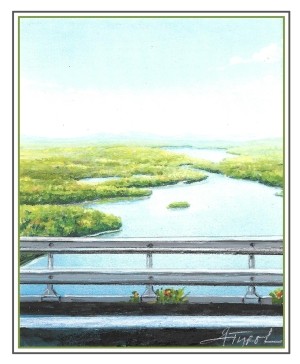
Road crews across the United States use more than 24 million tons of road salt (sodium chloride) to melt ice and snow each year – triple the volume used in 1975. Road salt is cost-effective and prevents traffic accidents. But there is an ecological downside to this practice: rain and meltwater dissolve and wash road salt into streams, rivers, lakes, and ponds, where it severely impacts aquatic life and degrades freshwater environments.
Chloride also enters waterways from other sources, including fertilizer runoff, septic systems, wastewater, and leachate from landfills. But more than 90 percent of the chloride polluting our waterways comes from road salt. Fifty years after Interstate-93 was constructed through Woodstock, New Hampshire, chloride levels have increased fourfold in nearby Mirror Lake.
“Road salt has been the number one contributor to increasing chloride in our waterways,” said Andrea LaMoreaux, president and policy advocate for NH LAKES, a non-profit organization focused on preserving and restoring the health of New Hampshire’s nearly 1,000 bodies of water. “According to the New Hampshire Department of Environmental Services (NHDES), in 2008 there were 19 chloride-impaired waterbodies in New Hampshire. In 2020, there were 50.”
Road salt washes into waterways, especially during heavy storm runoff. Although road salt is used during winter, the highest chloride levels typically occur during summer’s hot dry weather, when streams slow to a trickle and water levels drop in lakes and ponds. Monitoring data from Stoney Brook in Grantham, New Hampshire, which receives runoff from nearby Interstate-89, revealed chloride levels during severe summer heat and drought in 2019, 2020, and 2022 that were nearly 10 times the levels recorded during wet winter months.
Elevated chloride kills zooplankton, the minute animals that form critical links in aquatic food webs. Water flea populations, for instance, can drop 50 percent even where chloride levels meet water quality guidelines. Zooplankton consume algae, and are in turn eaten by aquatic insects, small fish, and other animals moving up the food chain. Absent healthy levels of zooplankton, populations of cyanobacteria (which can be toxic) are more likely to increase, as are invasive species tolerant of high salinity.
In addition, LaMoreaux notes that chloride-polluted water is denser than freshwater, which means it can become concentrated at lake bottoms. In extreme cases, this can impede the vernal and autumnal vertical turnover of lake waters essential for distributing oxygen and nutrients to aquatic species.
Citizen scientists provide crucial information to government agencies and environmental organizations that protect our waterways. The NHDES Volunteer Lake Assessment Program (VLAP) coordinates a statewide network of monitors, incorporates their findings into water quality research and management, and informs biologists about conditions in water bodies. The Watershed Management Division of Vermont’s Agency of Natural Resources has a similar program and distributes the Vermont Volunteer Surface Water Monitoring Guide.
James Lantz, a retired geologist, has been monitoring and recording conductivity levels, which serve as an indicator of chloride concentrations, in the Eastman Lake (also called Eastman Pond) watershed in central New Hampshire for the past 8 years, while also studying historical trends of nearby lakes. In the past 34 years, the conductivity of Eastman Lake has doubled, rising steadily since 1987 to four-to-five times the state median level. “The field data suggests that the main culprit is de-icing (salt) via runoff primarily from I-89,” said Lantz. “Perhaps half of this salt ends up in shallow groundwater, where it has been building up over many years. This conclusion is supported by field measurements during low flow in summer, when the larger proportions of stream flows are sourced from groundwater.”
Salt reduction zones can reduce chloride levels in nearby bodies of water. Vermont’s management program emphasizes using sufficient road salt to maintain “safe roads at safe speeds,” rather than a bare-roads policy that would introduce considerably more salt into the environment. Drivers are asked to employ patience and preparedness by not expecting bare roads immediately after storms, staying off snow-covered roads unless travel is essential, and running winter tires for traction.
The NH LAKES LakeSmart program encourages property owners to employ contractors who follow the NHDES Green SnowPro Certification Program guidelines, which mitigate road salt while emphasizing public safety. In 2022 NHDES awarded $80,000 to Merrimack Village for implementing a decade-long, watershed-wide “best management practices” program for minimizing road salt and reducing chloride pollution.
From driving habits and road management to citizen science, everyone can help reduce chloride pollution. “Ask yourself how you would balance road safety and lake health,” said Lantz. “We can do better.”


Discussion *